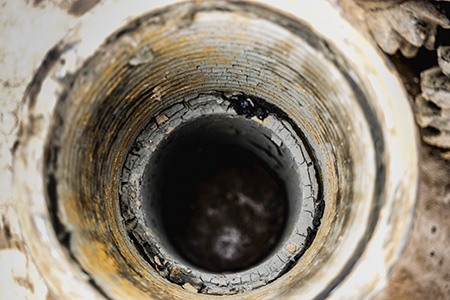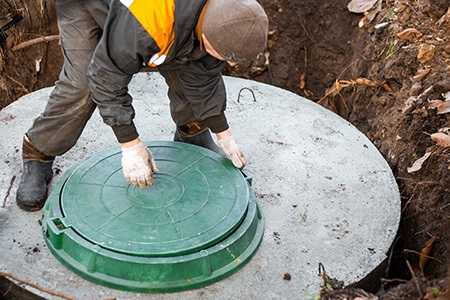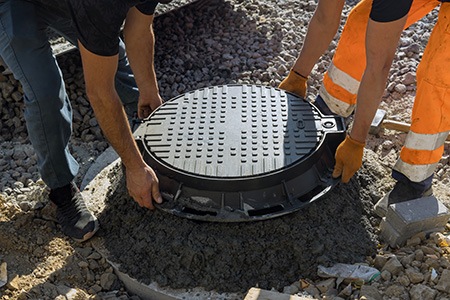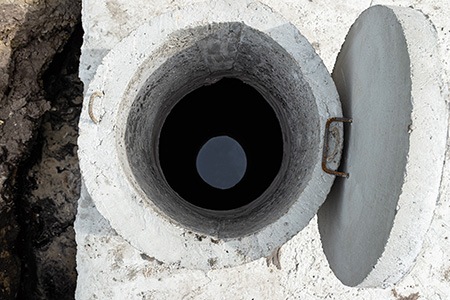2 DIY Home Remedies for Backed Up Septic Tanks
Author: Omar Alonso | Editor: Omar Alonso
Review & Research: Jen Worst & Chris Miller

Is your septic tank backing up? That's a downright dirty situation no homeowner wants on their hands, quite literally. When things go wrong with the septic tank, they can escalate into a nasty problem in no time, leaving your home smelling terrible. Let's look at the top-rated DIY home remedies for backed up septic tanks.
Prompt troubleshooting and correcting the problem ensures the smell and situation don't hang around longer than necessary. We'll give you the advice you need to resolve the problem as fast as possible.
Understanding Septic Tank Design & Operation
For those homeowners new to septic tanks and other types of septic systems, it's where the water and toilet waste go. Everything you drain through the sinks and pipes a go to the septic tank. All the debris that flows through the plumbing also ends up there, where the microorganisms and enzymes start breaking down the waste.
The septic tank features a design to drain liquids and break down solids it gets too full. For those readers thinking ahead, you're probably noticing the issue with all this already. If there's a blockage, clog, slow drain, or backed-up septic tank in your plumbing system, there's only one escape route for the waste.
That's right back up the pipes and into your home. Brown toilet water! Lovely.
Home Remedies for Backed Up Septic Tanks – Step-by-Step

Fortunately, you don't always have to call professionals to come and solve your septic tank problem. If you're willing to get down and dirty for a minute, you might solve the issue yourself, saving you some cash.
Here's a troubleshooting process to help you solve the issue and return the septic system and tank to the correct working order.
1) Locate the Source of the Problem
First, find the problem causing the issue. If you have a few drains backing up in the house, it makes finding the source of the problem that much easier, narrowing your search to find the offender.
2) Inspect the Pipework for Clogs
While it's somewhat of a messy affair, finding and fixing a clogged pipe causing the problem is relatively easy. After you find the culprit responsible for the backup, see if the line has a clog in it. Sometimes, you can use an old wire clothes hanger to solve the problem.
Undo the hanger and push the end into the drain to loosen the clog. If you have a plumbing snake on hand, that's the better tool, but not all homeowners keep one handy, so a hanger is your next best bet.
3) Examine the Water Level in the Tank
If the water level in the septic tank is low, there is usually an issue between the house plumbing and the tank. If the tank is overly full, you've got a problem with the tank's outlet drain. You must understand how the septic tank works to troubleshoot the problem effectively.
The issue at hand is that you usually can't see inside the pipework in the septic system when it has liquids in it. Obstructions in the septic system result in various issues causing the backup problem.
4) Look for Obstructions in the Tank

The tank is a prime location for obstructions and clogs in the septic system. Fortunately, it's easy to check if it's the issue behind the problem. Locate the tank inlet; it's a removable lid you pull off, revealing its interior.
The inlet is usually located somewhere around the tank's exterior. When you find it, open it, and take a look inside. If you find a clog, loosen it with a pole or broom handle.
5) Inspect the Outlet Baffle
If you get an air bubble in the system, it causes the same issue as a clogged line. Check the outlet baffle on the tank to see if there are obstructions.
Many homeowners find a bird's nest or small animal trapped in the space, causing the issue. If you remove the blockage or air trap and the system doesn't return to normal working order, something else is causing the problem.
6) Inspect the P-Traps
In instances where you have one sink backing up in your home, open the area under the sink to expose the P-trap. The P-trap is the U-shaped pipe underneath the sink drain. It prevents sewer gasses from rising through the drain into your home.
Place a bucket under the P-trap and remove the pipe. If it's blocked, gunk and water will drain into the bucket. After the P-trap is off, use a flashlight to check the plumbing for further blockages. If you find a clog, loosen it with your hanger or plumbing snake. This is a good time to fix your leaking p-trap as well.
Now let's look at our two home remedies for backed up septic tanks that you can try. If one works to a degree, you can try again to finish the job or switch to the other method to tag team it.
Home Remedy #1 – Dissolve Clogs With Baking Soda & Vinegar

Plumbing blockages are the number-one cause of septic tank backups. Fortunately, there are home remedies you can use to eliminate blockages and restore your pipes to working order. Baking soda and vinegar are safe to remove blockages and won't damage the septic system or drain field.
Don't use ammonia or bleach-based household cleaners, like Drano, to resolve the blockage. These chemicals harm the bacterial microbial balance in your septic tank, leading to more problems with the septic system.
Vinegar and baking soda won't cause these problems. It's also important not to pour boiling water down the drain to remove a blockage. The hot water causes cracks in the plumbing. Mix three tablespoons of baking soda with hot (not boiling) water and add half a cup of white spirit vinegar.
Pour it down the drain and wait for the natural effervescent action of the baking soda to work its magic on the clog. After a few minutes, use a plunger on the drain to loosen the clog.
Home Remedy #2 – Clear Clogs With Epsom Salts
Epsom salts aren't just for a hot steamy bath; salt is also great for loosening clogs in drains. As mentioned, you can; use chemical agents to remove clogs in septic systems. Epsom salts are safe for bio-cycle systems and septic tanks, provided you use the right quantity.
Unless you use huge amounts of Epson salts, this fix won't cause any issues with upsetting the microbial balance in the septic tank. In fact, Epsom salts in your grey water runoff benefit the plants around the soakage trench.
Mix two cups of Epsom salts with warm water in a bucket and pour the mixture down the drain. Give it a few minutes to work and attack it with the plunger to clear the clog.
Septic Tank Problems Unsuitable for DIY Remedies

There are some instances when your best DIY attempt won't solve the problem of the septic tank backing up. In these cases, you have no other option but to call professionals to resolve it.
Problem #1 – Leaks in the System
You have a leak if you notice the grass is greener in some areas around the septic tank. Grass and plants thrive on the nitrogen-rich wastewater coming from a leak.
Problem #2 – Damage to Septic Pipework
If you have damaged plumbing, you'll need to replace it. Weather damage, tree roots, or cracked pipes are problems requiring professional replacement.
Problem #3 – Mechanical or Electrical Failures
If the sensors, pump, or switch have a fault, you'll need a professional to diagnose and repair the problem.
Top Tips for Septic Tank Preventative Maintenance
Keep your septic tank in tip-top working order by following these maintenance tips past using home remedies for backed up septic tanks. An ounce of prevention is worth a pound of a fix!
Tip #1 – Only Flush Septic-Approved Waste
Don't flush anything but toilet paper and human waste down the toilet. Wet wipes, condoms, tampons, hair, cat litter, and cigarette butts are common causes of clogs in the septic tank and system.
Tip #2 – Pump the Tank Out Regularly
Set up a pumping schedule for the tank and adhere to it. Don't overrun the pumping cycle, or you'll experience problems.
Tip #3 – Locate the Drain Field Lines and Keep Trees Away
Find the drain field lines and avoid planting trees or digging around them. Don't plant them near the septic tank either as septic tanks aren't buried very deep.
Tip #4 – Avoid Chemical Drain Cleaners
As mentioned, don't put any ammonia or bleach-based chemical agents in the plumbing. Doing so kills the natural bacteria, and your septic tank won't be able to break down the waste.
Key Takeaways Regarding Resolving a Backed Up Septic Tanks

Let’s recap the main points from above in a quick summary:
- In some cases, you can clear blockages causing septic backups yourself
- Clogs are the biggest cause of backups in septic systems
- Check your home for backed-up drains
- Remove the P-trap in the sink to check for clogs
- Use a hanger or plumbing snake to clear drain blockages
- If you can't find blocked drains in the plumbing, check the septic tank itself
- Inspect the inlet and outlet baffle in the tank and look for blockages or air traps
- Sometimes, you'll have to call professionals to handle the job
- Ensure you hire a reputable plumber with a good reputation. Get a quote before authorizing the work
- Proper tank and septic system maintenance ensures you don't have future problems
- Don't plant trees or dig around the drain field lines to avoid damaging them
- Don't flush anything but TP and human waste down the toilet
Back ups are going to happen. Just be mindful of what you're flushing over time and what you're allowing in your garbage disposal, etc.
That's How to Fix a Backed Up Septic Tank By Yourself
These two home remedies for backed up septic tanks above can be all you need to save you an expensive visit from a specialist. Just make sure you abide by the guide of what not to use as much as what is safe to use, and you'll do just fine.



